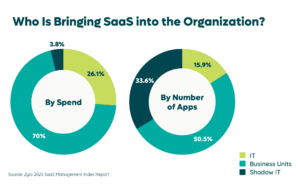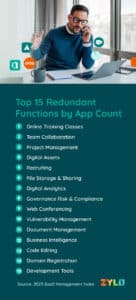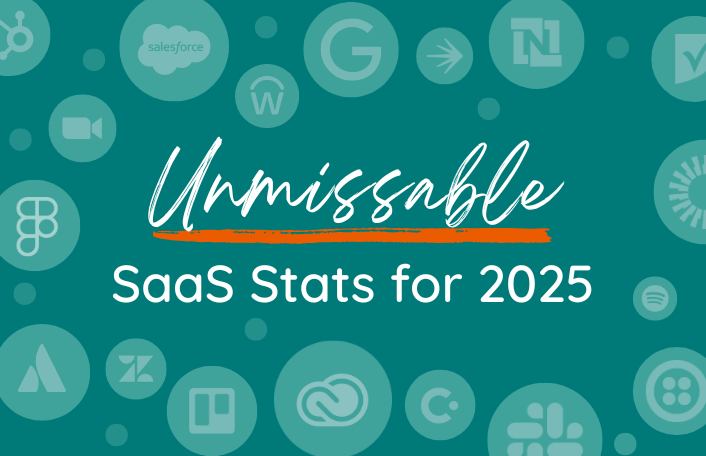
Standing Up SaaS Management: A People, Process & Tech Blueprint
Table of Contents ToggleChallenges SaaS Creates to Optimal Employee ProductivityApproaches to...
Back
Back
Search for Keywords...
Blog

Table of Contents
As cloud-based software rapidly replaces on-premises systems, most CIOs and their IT teams have come to value the role SaaS (service-as-a-service) plays in creating a more productive virtual and hybrid work environment. The trick lies in obtaining an accurate view of this cloud-based ecosystem and using those discoveries to develop an enterprise IT architecture that strengthens employee productivity — instead of derailing it.
A comprehensive SaaS Management strategy helps CIOs and other business leaders see exactly what’s deployed across all business units, how much those services cost, and measure workers’ SaaS engagement.
Organizations can capitalize on those valuable insights to optimize their technology inventory and leverage SaaS to improve employee productivity.
This is more important than ever to the employee experience in the wake of the pandemic and the great reshuffle. Both have forever changed the way we look at work. From the pandemic, employees saw the potential of digital tools for better flexibility and communication. Now, employees continue to expect these qualities in this new age of the digital workplace. The Great Reshuffle showed us the lengths employees are willing to go to work for an organization that gives them both.
If you look at an average employee’s smartphone or tablet, they likely rely on a variety of applications to provide entertainment, follow the news, track personal goals, manage finances, and much more. Their preference for curated, specialized technology doesn’t end when they log in for work each day. By 2023, Gartner predicts 40 percent of workers will choose business applications and tools like they do in their music streaming experience.
“The days of buying large monolithic applications and consuming different parts of the application while the rest of the parts sit idle are gone,” says Pranab Sinha, CIO at Genesys, a provider of cloud-based customer experience and call center technology. “The industry is moving to a consumption-based model where you pick and choose the best applications to fit your needs. You need a strong SaaS Management Platform, which provides a good view of what your enterprise and the economics look like.”
In this, we see why enterprises must implement a SaaS Management program if they want to achieve better employee productivity in this age of digital transformation. It’s what allows you to see the entire employee lifecycle for SaaS and consider how that lifecycle affects employee experience and productivity.
Genesys Leverages SaaS Management to Further Digital Transformation
See how the leader in cloud customer experience and contact center solutions reinforces software asset management and enterprise architecture with Zylo.
Although the rise of SaaS applications has empowered employees across industries with choices of what tools they work with, it has also created a number of problems that hinder employee productivity. All of these stem from SaaS’s ease of access and increasing decentralization.
Without complete visibility of your SaaS portfolio, you can’t know for certain what tools your employees are using. This offers a number of problems on its own, but in terms of SaaS, employee effectiveness requires you to know what tools work for them and what doesn’t. To know this, you’ll need to measure usage.
This, of course, is impossible without knowledge of your complete portfolio. Visibility is key to ensuring that employees have the right tools – the tools that fit your organization and meet employee needs. The introduction of application portfolio management into the frame of your enterprise architecture allows you to make this happen by creating an ongoing program as part of the company culture. This provides continuous visibility and management of SaaS with employee productivity in mind.
The lack of visibility across enterprises stems from yet another challenge of SaaS which prevents optimal employee productivity. It is the inherently decentralized nature of SaaS.
As IT’s share of software ownership declines, ownership spreads throughout the organization. In fact, IT owns just a mere 26% of spend and 16% of applications.

More and more, SaaS is expensed by individual employees to LOB leaders. For an enterprise as a whole, this leads to duplicative and redundant applications in the SaaS environment. This in turn causes inefficiencies and frictions that hinder employee productivity.
For example, marketing may use one project management tool while sales uses another. This could be true for any number of LOBs. No enterprise needs 14 separate project management tools. Not only is this cost inefficient, but it also prevents effective communication, collaboration, and data sharing between LOBs when their data is stored in different SaaS applications.
From decentralization and lack of visibility comes a lack of governance. This creates an environment where employees are unaware of the tools available to them and how to acquire new tools, causing confusion, inefficiency, and, ultimately, damage to the enterprise’s bottom line.
That’s why one of the main goals of SaaS Management is to establish effective governance that provides employee education on processes and policies on SaaS usage and acquisition.
Thankfully, there are approaches you can adopt to mitigate the challenges of SaaS. A SaaS Management program allows you to empower employees, mitigate risks, and increase the efficiency of your tech stack.
A common misconception of SaaS Management is thinking that effective program management requires a complete lockdown of SaaS acquisition. However, there is an alternative that’s healthier for the employee experience: empowerment.
SaaS Management can mean working with your employees to create a culture of trust, collaboration, and communication regarding a shared responsibility of SaaS. This empowers business units to self-manage application portfolios, as they’re more than SaaS users, they’re partners in the organization.
Aaqil Kassamali, senior manager of procurement at Hootsuite, shared how his team partners with others across the organization on SaaSMe Unfiltered.
Often, procurement gets the reputation of being a roadblock, requiring a look from security, privacy, and legal.
According to Kassamali, it’s about taking a partner mindset and showing them “We’ve got a little bit of business acumen here. We’ve done this before. We’re not going to block you, but you’re part of this company. You’re a shareholder. You want us to protect our data, our customers.”
The key is to say this in a way that doesn’t scare them away. For example, Kassamali said, “We’re going to do all [the work] behind the scenes, and we’re going to partner with you. You’re still going to buy, but we’re going to get those done the right way.”
Everyone works better when they know exactly what tools are available to them. That is why SaaS Management includes building a framework into your enterprise that allows employees to operate within limits.
This harkens back to governance. Whether your organization prefers an approach that is centralized, decentralized, or somewhere in between, a framework is vital to ensure employees get what they need. In the process, applications are properly vetted and purchased, minimizing risk to the organization.
Remember the employee flexibility we discussed? You can still give it to them, but within a framework. With education and communication, you can ensure that employees know what tools are available to them, and understand the process to acquire new tools.
Allowing employees this level of tool autonomy in the workplace promotes employee productivity by allowing them to work with the tools they are comfortable with.
Evolving Your SaaS Governance Framework for the Digital Workplace
Learn MoreBy now, you’ve most likely noticed a theme of communication in these approaches. That is because communication and collaboration are key to any approach to SaaS Management, as it brings the whole organization together behind the same goals and understanding. This means keeping employees informed and educated on the reasons behind your processes and procedures.
Answer important employee questions about your SaaS policy such as:
Communicating the answers to these questions helps keep employees informed of available tools and how to get them. Not to mention, no one enjoys operating within a system without understanding its purpose.
Following this approach is also an opportunity for IT or procurement teams to become valuable business partners across LOBs. By going out into the business, you’re able to learn the unique needs of each department and the value they do or don’t receive from existing tools. This improves tool-to-business alignment by allowing for better-informed purchasing and renewal decisions.
Employees need to be in the loop of how policies work.
“People get scared like, ‘How long is this going to take? Why is this going to take so long?’” said Kassamali on SaaSMe Unfiltered. “Because sometimes things take time. We’re unpacking that for our internal customers to show them why. What we’ve done this year that’s been great is that we partnered with IT to build a procurement landing page center. From there you can look at templates and guides, and you can make all your requests through there. That’s been a scaling game changer for us.”
A good place to start this education is the onboarding process for new employees. Establishing this policy education early in their employment helps them ramp up faster while boosting employee productivity and effectiveness.
Additionally, this communication needs to happen frequently, not just with individual employees, but with departments as a whole to keep the tools up-to-date and aligned with business needs.
This is what Karen Hodson, global procurement and real estate officer for CM group, had to share with us on SaaSMe Unfiltered about how proactive conversations with each department helps you understand the purchasing landscape.
“We will sit typically on a monthly basis and evaluate what’s coming up in the next 30, 60, 90 days.” said Hodson. “Potentially longer, depending on the tool. It’s about being proactive versus reactive. And the only way to be proactive is to have conversations with those that are buying these tools or wanting these tools, to understand their needs. … There’s a lot of discussions with each department, and because of that, we have this overall view of what everybody is buying.”
If anything is true about the 21st century, it’s that people like things quick and easy. That includes your employees and SaaS acquisition. The ease of access to SaaS is what makes it so appealing to begin with. So, create a one-stop shop with an application catalog for employees to centralize your application intake.
This will make acquisitions easier to manage while also making sure SaaS acquisition remains an easy process for your employees.
Again, no one likes being kept in the dark. Be transparent with your employees.
For example, You may deny an employee’s request to use a free application, which can be naturally frustrating to the one requesting it.
They’ll want to know, “Why didn’t it get approved? It’s a free app.”
That’s when you can explain how that app has security or compliance issues that would introduce unnecessary risk to the enterprise. It’s not about the cost nor a parental “because we said so.” It’s about creating an understanding between partners invested in protecting their shared organization.

How do you know if the selected SaaS applications truly represent the top options for a particular business process? If you don’t monitor SaaS application utilization, it’s impossible to know if employees actually use and value the software.
Most applications track license-specific utilization data via a dedicated metrics dashboard. However, measuring SaaS application usage manually can prove difficult and time-consuming—especially for large enterprises.
To truly understand your full SaaS utilization, frequently measure all users of every application. Find a SaaS Management Platform that directly integrates into mission-critical applications, like your CRM, web conferencing, product management applications, and office suites, to accurately measure application utilization across the entire software portfolio.
Another way to ensure employee productivity is to adopt a continuous system of application portfolio management to keep the SaaS stack aligned with business needs. In the process, this system accounts for all changes in the portfolio including license renewals and opportunities to optimize.
It’s important to ask the following questions when deciding which SaaS applications to keep and which to eliminate from the stack:

Application rationalization involves deciding which software services should remain in use and which applications should be replaced, consolidated, or retired. This is an excellent step to take when you see apps with low usage and adoption. Consolidation gets more employees on the same application for easier and stronger collaboration.
From there, it’s important to consider how the SaaS catalog fits into the enterprise IT structure to streamline requests, spending, and improve access.
Atlassian, which develops software and collaboration tools like Trello and Jira, uses the Zylo SaaS Management Platform to inform internal IT management and improve its own enterprise architecture. The enhanced transparency gained through application rationalization drives the international company’s decision-making and leads to a more effective architecture overall, according to Atlassian’s Senior Enterprise Architect John Stame.
“When you discover applications and start to put them in context from a business architecture perspective, you’re mapping everything by capability or function,” Stame says. “You start to see where you probably don’t need 17 separate learning solutions.”
SaaS Management isn’t a one-and-done project. It’s an ongoing program to strengthen your entire SaaS portfolio while accounting for the dynamic nature of SaaS applications. As such, you must regularly monitor this ongoing program to see what effect it’s having on your employees and business.
To determine if your SaaS Management approach is working, you’ll need to measure the key metrics. Is there a shift in employee-led purchases? Have you moved more contracts over to Accounts Payable/Purchase Orders? To answer these questions, we’ll have to circle back to the first problem of SaaS: visibility.
Zylo provides a comprehensive SaaS Management Platform to help you boost employee productivity.
Our Discovery Engine provides complete visibility into your SaaS environment. Which we know is essential to creating a portfolio that drives employee productivity. After all, it’s impossible to measure an app’s effectiveness if you don’t know it exists in the first place.

What’s more, Zylo’s app catalog empowers employee productivity by allowing you to create that centralized self-service one-stop shop for all your employees’ SaaS needs. Not only do employees get what they need, you also head off compliance and security issues.
And for a serious boost, you can rely on Zylo’s team of experts in Managed Services. A dedicated SaaS services manager becomes an extension of your team, helping you set up intake processes, monitor your environment, and work alongside your application owners to build a strong foundation for maximized employee productivity.
Schedule a personalized demo today to experience how Zylo can change the way you see your SaaS.

Table of Contents ToggleChallenges SaaS Creates to Optimal Employee ProductivityApproaches to...

Table of Contents ToggleDefining AI in the WorkplaceThe Rise of AI...

Table of Contents ToggleChallenges SaaS Creates to Optimal Employee ProductivityApproaches to...

Table of Contents ToggleChallenges SaaS Creates to Optimal Employee ProductivityApproaches to...
| Cookie | Duration | Description |
|---|---|---|
| cookielawinfo-checkbox-analytics | 11 months | This cookie is set by GDPR Cookie Consent plugin. The cookie is used to store the user consent for the cookies in the category "Analytics". |
| cookielawinfo-checkbox-functional | 11 months | The cookie is set by GDPR cookie consent to record the user consent for the cookies in the category "Functional". |
| cookielawinfo-checkbox-necessary | 11 months | This cookie is set by GDPR Cookie Consent plugin. The cookies is used to store the user consent for the cookies in the category "Necessary". |
| cookielawinfo-checkbox-others | 11 months | This cookie is set by GDPR Cookie Consent plugin. The cookie is used to store the user consent for the cookies in the category "Other. |
| cookielawinfo-checkbox-performance | 11 months | This cookie is set by GDPR Cookie Consent plugin. The cookie is used to store the user consent for the cookies in the category "Performance". |
| viewed_cookie_policy | 11 months | The cookie is set by the GDPR Cookie Consent plugin and is used to store whether or not user has consented to the use of cookies. It does not store any personal data. |
